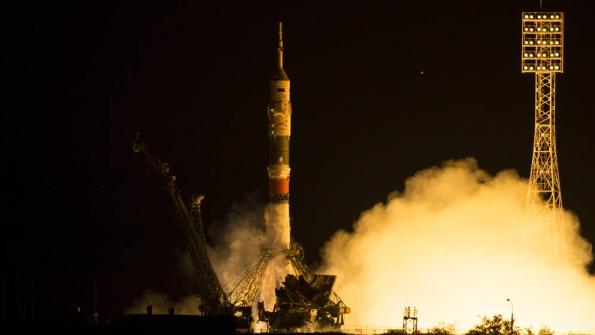ISS Resumes Six Person Operations With Soyuz Crew Arrival

The International Space Station has resumed six person operations for the first time since early June, with the launch and docking of Russia's Soyuz TMA-17M spacecraft late Wednesday carrying three U. S., Japanese and Russian astronauts.
The docking at 10:46 p.m., EDT, was carried out in spite of difficulties with the deployment of one of two power generating solar arrays in the minutes after the Soyuz booster's successful climb to orbit from the Baikonur Cosmodrome in Kazakhstan. The TMA-17M lifted off at 5:02 p.m., EDT, or Thursday at 3:02 a.m, local time.
The automated docking of the Soyuz crew transport with NASA's Kjell Lindgren, Japan's Kimiya Yui and Russia's Oleg Kononenko followed after four orbits. The newcomers were greeted at the Russian segment Rassvet docking port by Gennady Padalka, the ISS commander, fellow cosmonaut Mikhail Kornienko and NASA's Scott Kelly.
Concerns over the deployment of the port Soyuz solar array seemed to come and go after the capsule climbed to orbit in the pre-dawn darkness without issue. Flight controllers reported a successful deployment of one of the arrays after the capsule reached its preliminary orbit nearly nine minutes after liftoff, then difficulties with the port array, followed by reports of success with both after a round of troubleshooting.
As it turned out, the port solar array did not deploy -- a reprise of a similar problem during the launch of the Soyuz TMA-14M to the ISS on Sept. 26, 2014 with two cosmonauts and a U. S. astronaut.
In the 2014 case, the port array successfully deployed after the Russian capsule docked with the ISS. In the case of the Soyuz TMA 17-M, the port array finally locked into place as the capsule was on final approach for the docking.
Despite the difficulty, the TMA-17M had sufficient electrical power as it sprinted to the ISS, said Kyle Herring, a NASA public affairs officer positioned in the agency's Mission Control Center in Houston.
As the TMA-17M sped toward the docking, Russia's Mission Control instructed the station crew to obtain photographs of the approach.
"The solar array is of high interest," flight controllers in Moscow informed the astronauts about 90 minutes before the scheduled link up.
The ISS has been restricted to three rather than six person operations since the June 11 departures of NASA's Terry Virts, the European Space Agency's Samantha Cristoforetti and Russia's Anton Shkaplerov, after 200 days in orbit.
Originally scheduled for May 26, the launching of Lindgren, Yui and Kononenko was delayed by the April 28 launch failure of Russia's Progress M-27M/59 mission. Spinning out of control as it separated from its Soyuz launch vehicle, the Russian freighter soon lost communications with Russia's Mission Control. Within days, it made an uncontrolled re-entry into the Earth's atmosphere with more than 6,100 pounds of undelivered crew supplies and science equipment.
The late April Progress loss was bracketed by the launch failures of both U. S. commercial cargo providers, SpaceX on June 28 and Orbital ATK on Oct. 28, as the the Falcon9/Dragon and Antares/Cygnus spacecraft departed the Cape Canaveral Air Force Station, Fla., and Wallops Island, Va., respectively.
"I know we have had sort of a challenging period with logistics vehicles over the past few months," NASA's Mike Suffredini, the ISS program manager, told Lindgren, Yui and Kononenko on the eve of their lift off, during a pre-launch news conference at Baikonur.
Russia recovered from the late April Progress loss July 3-5 with the successful launch and docking of the Progress M-28M/60 re-supply mission. And Japan's fifth HTV resupply mission to the ISS is scheduled for mid-August, according to Suffredini, who sounded an optimistic note for recoveries by Orbital's Antares/Cygnus and SpaceX's Falcon 9/Dragon resupply spacecraft by the end of this year.
"The Cygnus spacecraft is on scheduled to return to servicing the ISS in early December, and I think Dragon will be there about that time as well," said Suffedini.
Lindgren, a former NASA flight surgeon and medical doctor trained in aerospace as well as emergency medicine, and Yui, who is a retired member of the Japan Air Self Defense Force, launched for the first time on Wednesday.
Kononenko logged 391 days in orbit over two trips to the ISS in 2011-12 and 2008.